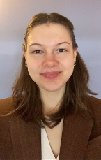Lieve Baetens is Student Cultural Heritage/Former intern selection and preservation immersive media at the Netherlands Institute for Sound and Vision and is pursuing a bachelor’s degree in Cultural Heritage. She interned at the Netherlands Institute for Sound and Vision where she researched strategies for the selection and preservation of immersive media.
During my internship at the Netherlands Institute for Sound and Vision I conducted the research titled “Collaboratively Moving Forward: Exploring Strategies for the Selection and Preservation of Immersive Media in Cultural Heritage Institutions”.[1] As the name suggests, the research emphasizes the importance of institutional collaboration for selecting and preserving immersive works.
As part of the research, I interviewed fourteen experts in the field from ten institutions in total. I was very pleasantly surprised about how willing everyone was to contribute to the research. From listening to the interviews with these experts on one of my favorite podcasts called “Art & Obsolescence” hosted by Cass Fino-Radin, to being able to meet these experts and talk with them about immersive media made me very happy. As a young professional it was wonderful to experience how welcoming the digital preservation community is. It made me realize that digital preservation truly is a concerted effort.
It is not only a concerted effort to ensure that new professionals find existing networks and are welcomed into these communities. Institutions are also very eager to share knowledge and contribute to collaborating initiatives. This is of great importance when it comes to preserving immersive media in cultural heritage institutions. We all know that collaboration is important in this field, but why is it especially important when it comes to preserving immersive media?
As Tom Ensom and Jack McConchie explained in their research about preserving virtual reality, time-based media conservators are used to experiencing difficulties when preserving technology-based artworks.[2] However, the preservation risks of immersive media are amplified. It is difficult to establish a common policy for the preservation of immersive media due to the rapidly changing and quickly becoming obsolete technology. Besides this, immersive media is a broad term that consists of multiple technologies. The different technologies require different preservation strategies.
This means that preservation strategies for immersive media are often bespoke. It takes time to find a strategy that is a good fit for each work. From what I have learned so far in the field of digital preservation, time is always a factor that we would like to have more of. Since preserving immersive media is time-consuming, it is important that institutions share strategies that have worked for them so other institutions can try to apply those strategies as well. By sharing knowledge, together we can eventually make a policy which contains multiple good practices that fit different types of immersive media.
There are already great examples in place of collaboration between institutions when it comes to preserving immersive media in cultural heritage institutions. For example, the Preserving Immersive Media Knowledge Base. This initiative is a collaboration between Tate and Sound and Vision to share resources about immersive media preservation.[3] Or the open-source Acquisition workflow for software-based artworks by ZKM that immersive works can greatly benefit from.[4]
Based on the findings of the research I made recommendations to further improve the institutional collaboration for preserving immersive media. I would like to share some of these recommendations with you:
The first recommendation is to not only collaborate, but also co-create with other institutions in making strategies for immersive media. Secondly, organize online meeting spaces to discuss challenges and findings in immersive media preservation and make sure that institutions who are new to preserving immersive media know where to find existing meeting places. And third, collaborate with institutions that have similar preservation goals that align with the goals of your institution. When choosing a preservation strategy, you have to make certain decisions, such as if it is acceptable if the preservation strategy will slightly alter the work. Institutions with different institutional goals might make different decisions. If you find institutions with similar goals, you can share means and research preservation strategies together.
Additional recommendations can be found in the conclusion of the research.[5] On September 26, 2023, Sound and Vision organized a webinar about selecting and preserving immersive works. The webinar included a panel discussion with experts Candice Cranmer (ACMI), Dragan Espenschied (Rhizome), Jack McConchie (Tate) and Gaby Wijers (LIMA). If you would like to learn more about this topic, I highly recommend watching it.[6] And if you have additional insights, please share those with the community so we can all collaboratively move forward in exploring strategies for immersive media.
Bibliography
arden, sasha, Rasa Bocyte, Tom Ensom, Eric Kaltman, Jack McConchie, Jesse de Vos, and Samantha Rowe. ‘Preserving Immersive Media Knowledge Base’. https://pimkb.gitbook.io/pimkb/.
Baetens, Lieve. ‘Collaboratively Moving Forward: Exploring Strategies for the Selection and Preservation of Immersive Media in Cultural Heritage Institutions’. Sound and Vision, August 10, 2023.
Ensom, Tom, and Jack McConchie. ‘Preserving Virtual Reality Artworks’, August 13, 2021. https://www.tate.org.uk/documents/54/tate_pim_preservingvrartworks_01_00.pdf.
Webinar Collaboratively Moving Forward, 2023. https://drive.google.com/file/d/1RSV-cteEqOcEUYrbmWR4OUxh8ulYzVF2/view.
ZKM Werke Wiki. ‘Acquisition workflow (Software-based artworks)’. https://werke.zkm.de/wiki/index.php/Acquisition_workflow_(Software-based_artworks)#Post-Acquisition_marathon_(be_prepared_to_be_proactive).
[1] Lieve Baetens, ‘Collaboratively Moving Forward: Exploring Strategies for the Selection and Preservation of Immersive Media in Cultural Heritage Institutions’ (Beeld & Geluid, August 10, 2023).
[2] Tom Ensom and Jack McConchie, ‘Preserving Virtual Reality Artworks’, August 13, 2021, 41, https://www.tate.org.uk/documents/54/tate_pim_preservingvrartworks_01_00.pdf.
[3] sasha arden e.a., ‘Preserving Immersive Media Knowledge Base’, https://pimkb.gitbook.io/pimkb/.
[4] ZKM Werke Wiki, ‘Acquisition workflow (Software-based artworks)’, https://werke.zkm.de/wiki/index.php/Acquisition_workflow_(Software-based_artworks)#Post-Acquisition_marathon_(be_prepared_to_be_proactive).
[5] Lieve Baetens, ‘Collaboratively Moving Forward: Exploring Strategies for the Selection and Preservation of Immersive Media in Cultural Heritage Institutions’ (Beeld & Geluid, August 10, 2023) 33-36.
[6] Webinar Collaboratively Moving Forward, 2023, https://vimeo.com/871488367/7ae86eed78?share=copy

Comments